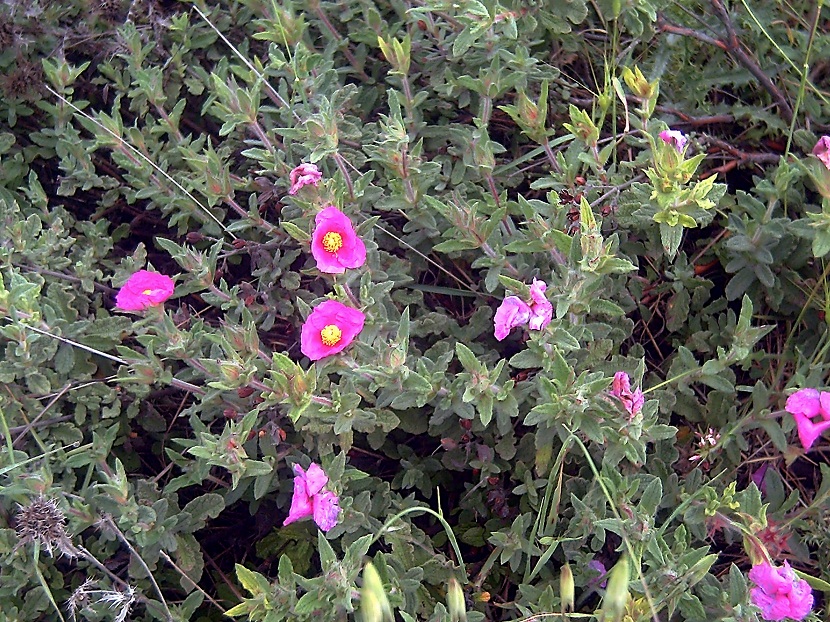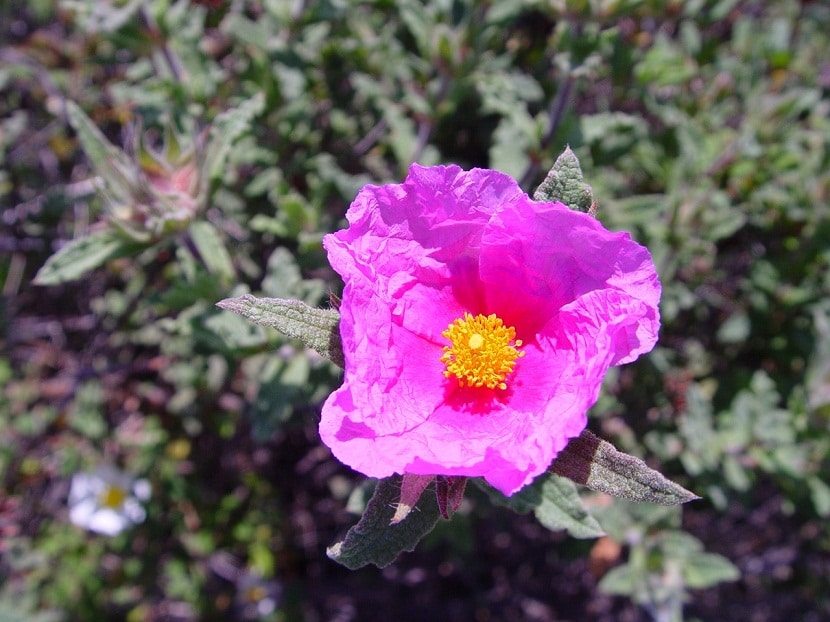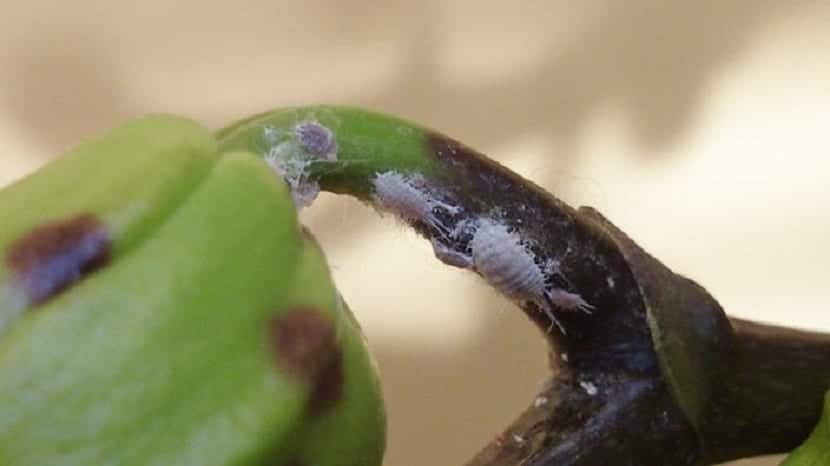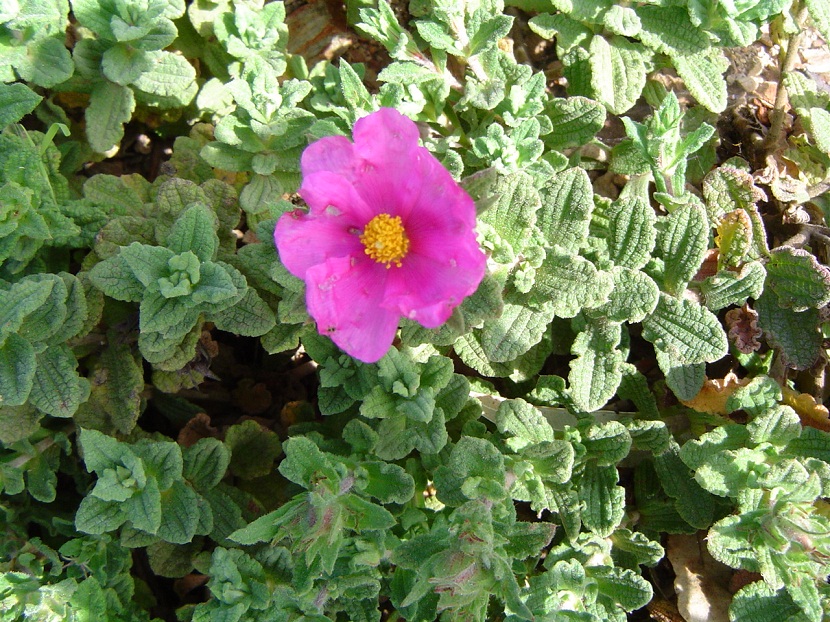
cistus crispus or curly rockrose, that is how this shrub native to the western Mediterranean is known. It also has other popular names, such as arrancasapos, steppe or white jagz.
Don't lose details at characteristics, care and uses of this incredible bush.
Features cistus crispus

This bush reaches a height of 60 cm, it consists of stems and branches of starry and simple hairs that make it look very leafy. The leaves have an elliptical-oblong shape, with a rough blade and wavy edge, they grow opposite and seated, reaching a size of 3 cm long and 1 cm wide.
The flowers of this shrub are usually large, terminal, and form both singly and in groups. The calyx is made up of 5 non-uniform sepals and the corolla of 5 pink and radial petals. The stamens are abundant and surround the multi-skinned ovary.
El cistus crispus it blooms in the spring, between the months of April and June. Regarding the fruit of the curly rockrose, It is a kind of oval capsule with 5 leaflets. The seeds are dark in color, smooth and barely 1 mm long. Reproduction takes place through the seed.
The shrub occurs easily naturally in areas where there are scrublands and Mediterranean scrub, on red and decalcified substrates, hot climates and reference in soils that are flooded in winter season. For example in the entire western region of the Mediterranean that includes from Portugal, Morocco to Sicily and Tunisia.
In general, this shrub has some characteristics that make it unique, it is that a good part of its species manage to survive fire and not only that, but it contributes to the germination of seeds. It should also be noted that some of these species contain resin, which makes them burn even when green.
A good part of these have ornamental applications and some have medicinal properties. This genre it is characterized by being evergreen, which means that they always look leafy or with abundant leaves that are in continuous replacement. They also emit a wonderful aroma, the bark is apparent and they are always covered with abundant hairs that serve as protection.
The flowers are characterized by their hermaphroditic condition as well as being very showy. They have 5 sepals and of these the two that are in the outer part can be more or less small than the 3 in the inner part. Even though there are some species that lack these epicalyx or outer sepals.
The petals are very beautiful and colorful, there are five in total and they are usually wrinkled in the bud. The tones are purple, red, white and pink. Some have purple or yellow spots that go towards the base and have multiple fertile and pluriseriate stamens, however the amount varies according to the species from 30 to 150 stamens.
The ovary is straight and elongated, presenting 5 locules and 5 carpels, while the stigma is large and consists of 5 to 12 lobes with their orthotropic seminal rudiments. To attract insects they use striking coloration, the size of the flowers and the abundance of pollen that the stamens generate, which compensates for the lack of nectar and aroma of the flowers.
The fruit is characterized by its capsule shape which is found on the stems of the fruit, this is opened by the central nerve of the carpels to divide into 5 valves. As for the seeds, these are abundant in most species of rockrose. They are polyhedral and have a threadlike embryo with linear cotyledons and circinate.
Finally we can add that some of these species are attributed medicinal properties, such as: antibacterial, antifungal, antiviral, anticancer, antioxidant, anti-inflammatory, etc.
Uses of cistus crispus
This shrub is used to beautify gardens with its showy and colorful flower that together with the intense green of the leaf and the pleasant aroma that it emits and that becomes more intense with the rain, make it perfect to place it in gardens or parks. There are no known uses for applications in the field of health or cosmetics.
Care
The truth is a very undemanding plant in terms of care, in fact when it is wild it grows in quite precarious soil conditions. If you have in your garden you should know that even when it tolerates periods of drought and little intense frosts very well, With a little watering in summer it will look more leafy and beautiful. It is a plant to be exposed to the sun, it requires a pruning of about 1/3 a year so that it always remains leafy.
There are at least about 70 species of Cystacea, family to which rockrose belongs, of these there are those that have the ability to grow in acidic rocks, slate or granite which are called calcifugas. They are found sparsely in light forests where the climate is sub-Mediterranean or Mediterranean, although they are also found in some oak and oak forests.
Management
Gray mold
A disease that produces a fungus called Botrytis cinerea, which produces large amounts of mycelium and the aplicular cells of these form clusters of conidia, which affect the plant generating necrosis in leaves, buds and seedlings, flowers and shoots. Appears when there is excess moisture.
Chancre
This is a product of Botryosphaeria dothidea, is recognized because it produces necrosis first and then the cankers appear, which are Elongated cortical lesions that even invade the entire branch.
Pests
Cochineal

The mealybug is a tiny insect It is identified because it is covered with a kind of white powder with a waxy consistency, which feeds on the sap of the leaves, making small holes in it until the leaf is lost.
Aphid
It is possible to locate aphids in stems and branches of the plant, since from there they consume the sap of the same until causing death. Sometimes they settle in the flowers and branches and they secrete a sugary substance through the anus that ends up affecting the plant.
Red spider
It is visualized in the leaves and stems by means of small red dots, it gets its food from the cellular contents of the leaves to which generates a pale spot that gets worse, affecting the photosynthesis process.
